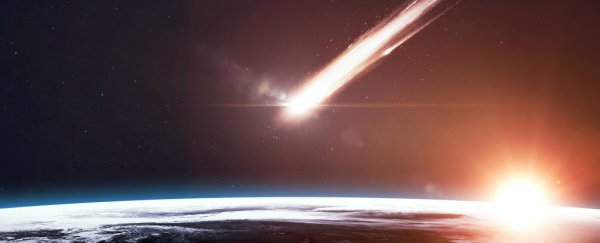Around 471 million years ago, life in our oceans exploded with new species. It was one of the greatest biodiversification events in our planet's history - but a new study suggests that, contrary to popular belief, this important moment in evolution wasn't triggered by meteorites.
Right now, the leading hypothesis is that Earth was bombarded by space debris, which triggered new species to emerge from our oceans at an unprecedented rate. But new research has found evidence that the evolution event actually started 2 million years before space rocks started raining down on us, suggesting that something else was behind the mysterious explosion of life.
"This study shows that the two phenomena were unrelated," the researchers, led by Anders Lindskog from Lund University in Sweden, write in a new paper.
As Lindskog told the AFP, there was "no measurable 'extraterrestrial' influence on biodiversity" in Earth's oceans.
So what is a biodiversification event? While simple life forms have existed on Earth for around 3.7 billion years, the evolution of life from a few single-celled organisms to all the weird and wonderful species we see on the planet today hasn't been steady.
Instead, many of the major advances in evolution have occurred in stops and starts, with long periods of slow progress followed by a few bursts of diversification - usually triggered by a major event or climate shift on Earth.
One of the most famous of these diversification periods is the Cambrian explosion, which occurred roughly 540 million years ago, and in a relatively short period of time, it gave rise to nearly all of the modern phyla - the biological classification that sits between Kingdom and Class - we still see on Earth today.
Around 70 million years after the Cambrian explosion, there was another major diversification event, known as the Great Ordovician biodiversification event (GOBE).
The GOBE occurred around 471 million years ago, and saw many of the distinctly Cambrian species die out in Earth's oceans, and the rapid evolution of many of the marine organisms that would dominate for the rest of the Palaeozoic Era - including many filter feeders, such as the ancestors of krill.
In terms of giving rise to new phyla, this event wasn't as impressive as the Cambrian explosion, but the GOBE produced an incredible four-fold increase in the number of genera that were on the planet.
So while the Cambrian explosion laid the groundwork, the GOBE filled in a lot of the diversity on Earth.
But scientists have long puzzled over exactly what triggered this event. The leading hypothesis is that the GOBE was sparked by a collision of objects in the asteroid belt between Mars and Jupiter, which rained debris down on our planet.
That kind of meteorite bombardment wouldn't have been devastating for life on Earth, but it would have provided just enough stimulation to trigger new evolution, past studies have suggested. It's not clear how the meteorites would have stimulated new life to evolve, but it's likely they would have caused environmental disturbance that would have carved out new ecological niches for species to fill.
But the Lund University researchers recently found a whole lot of new sediment that contained traces of these meteorites from around the time of the GOBE, and say new dating of the crystals within have shown that the timelines don't add up.
The dating was done using two different measures - the researchers firstly looked at the grains of zircon preserved in the crystal. Zircon is known to act like a chemical clock, seeing as its isotope ratio changes over time in very specific ways.
Measuring these isotopes, the team dated the meteorites to around 467.5 million years, give or take 0.28 million years, which would mean they landed at least 2 million years after species start arising during the GOBE.
Lindskog and his team then looked at the amount of noble gasses found in the meteorites, which allowed them to calculate when they were first ejected into space. This time stamp came back with a pretty similar estimate of 468 million years, with an error margin of 0.3 million years.
These are the most precise dates available for the age of this meteorite bombardment, and they suggest that they couldn't have been the trigger of the explosion of life 471 million years ago.
"This allowed us to confidently dismiss the asteroid breakup and subsequent meteorite bombardment as significant 'players' in the GOBE story," Lindskog told Maarten Rikken from ResearchGate.
"The GOBE started well before the asteroid collision even took place."
So if meteorites didn't spark this diversification of life on Earth, what did? Lindskog suggests a less dramatic hypothesis - that the GOBE was triggered by a combination of events and processes on Earth, such as high sea levels and the break up of continents.
"It is reasonable that the very high sea levels at the time contributed to the development, as the large shelf areas simply gave more space for life to thrive," he told Rikken.
"Combined with the presence of many small continents and beneficial cooling climate change, we have a pretty nice grand recipe for biodiversification."
For now, though, this is just another hypothesis, and until we learn more about the geology and fossil record of that time period, the cause of one of the most explosive evolution events on Earth remains a mystery.
The research has been published in Nature Communications.
